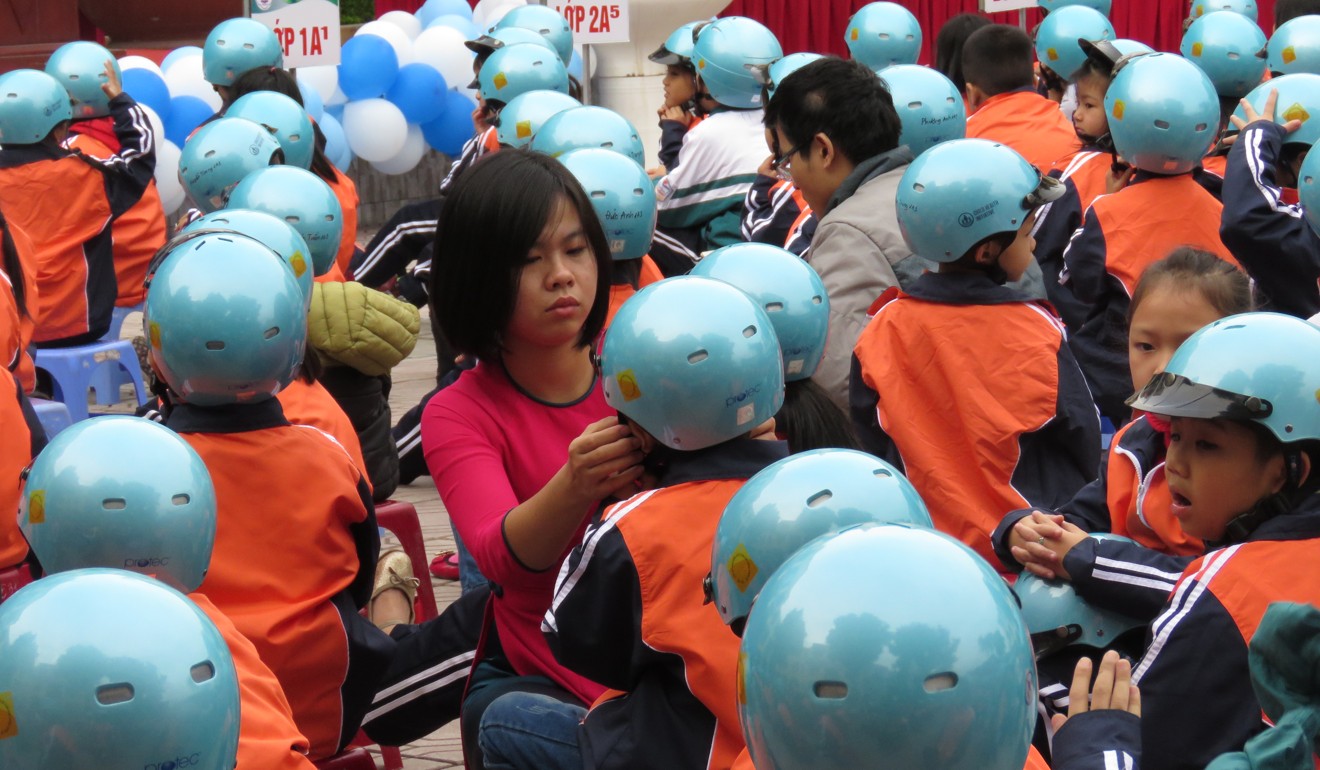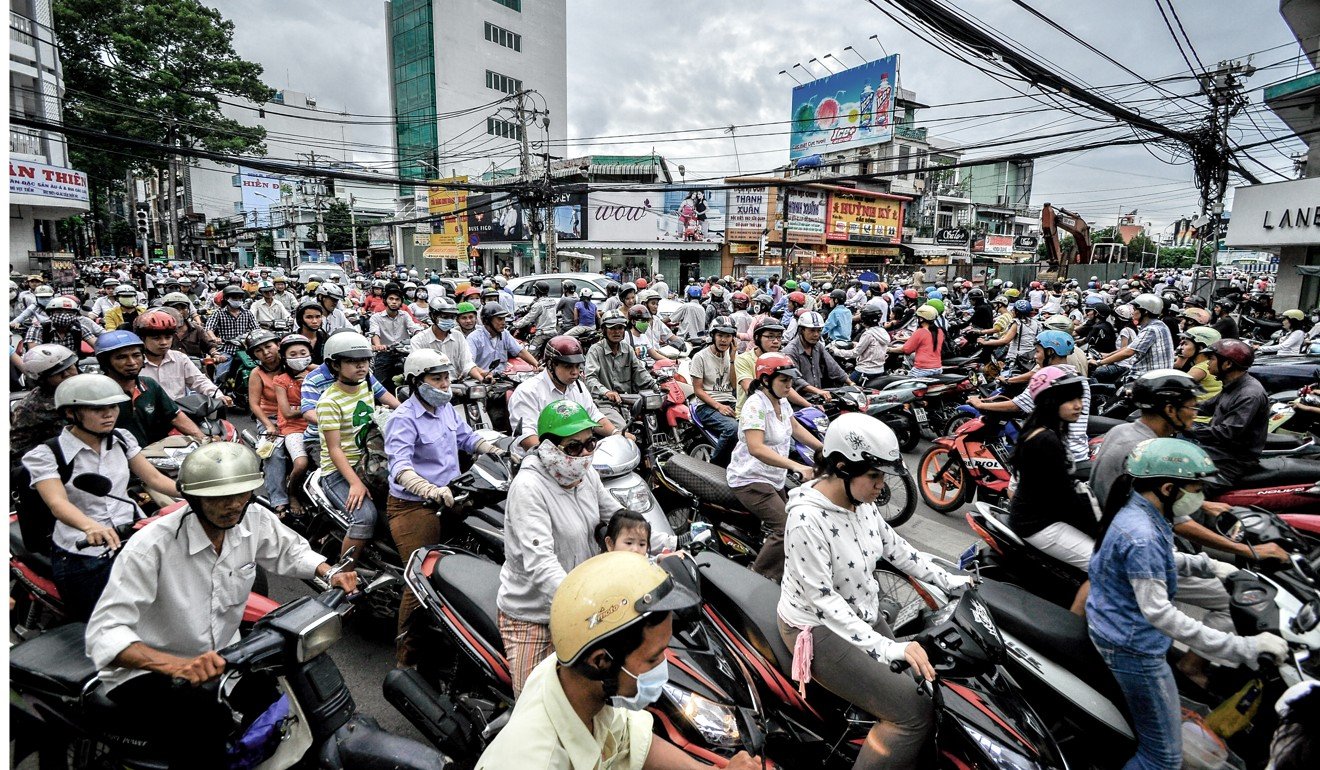
The lessons from Vietnam’s helmet law
Ten years of enforcement and public awareness campaigns have made a dent in motorbike fatalities, but other nations should take note – old, reckless habits die hard
“Fun with Traffic Safety” Day at Tien Phong Primary School in Hanoi on a recent Friday began with chants about when you should wear a helmet on a motorbike (always), and included a performance by a bicycling circus monkey wearing a helmet designed especially for its small head.
Students painted miniature clay helmets and danced to a song about helmets set to the tune of Gangnam Style. Everyone went home with a shiny blue or orange helmet.
The helmet giveaway, one of many such events regularly organised by the Asia Injury Prevention Foundation (AIP), was part of Vietnam’s celebration of the 10th anniversary of its comprehensive mandatory helmet law, Resolution 32. For the past decade, the government and a host of NGOs have worked to make helmets as ubiquitous as motorbikes, which were a symbol of social mobility when Vietnam began economic reforms in the 1980s and now account for 95 per cent of the country’s registered vehicles.

Vietnam’s traffic fatality rate of 24.5 per 100,000 is Southeast Asia’s second-highest, according to the World Health Organisation (WHO). But the figures would be grimmer without the helmet law, which AIP estimates has saved 15,000 lives. Before Resolution 32 took effect in December 2007, helmets were a rare site on the country’s motorways. Today, more than 90 per cent of drivers wear them, thanks to strict initial enforcement, sustained public awareness campaigns and traffic safety education programmes such as the one at Tien Phong.
“Even if the helmets are too old, maybe fake, people put the helmets on,” said Dr. Pham V. Cuong, director of the Centre for Injury Policy and Prevention Research at the Hanoi University of Public Health.
At a recent anniversary event for the regulations, policymakers and experts said the laws still have major shortcomings: fewer than half of Vietnam’s children regularly wear the protective gear, and some say as many as 80 per cent of the helmets being worn are insufficient or unsafe.
End of the road for Indonesia’s motorbikes?
But for other societies where motorcycle use is growing rapidly, Vietnam offers a road map for transforming public behaviour, safety advocates say.
Low- and middle-income countries suffer 90 per cent of the world’s road traffic fatalities, in part
because so many road users rely on two-wheeled vehicles.
“I call it the dark side of globalisation,” said Greig Craft, who founded AIP in Vietnam in 1999. “This is prosperity kicking in, giving people mobility, which is critical as a human right. But there is a dark side, as the statistics show. This is truly a crisis.”
‘Bad for children’s necks’
Cong Thi Hai, a 44 year-old small-business owner, waited beside her motorbike to pick up her nine-year-old son from his school in central Hanoi on a recent afternoon. He started wearing a helmet when he was a toddler, though other parents objected.
“When they saw my four-year-old was wearing a helmet, they told me that helmets are bad for children’s necks,” she said.
Around the time the law came into effect, Dr Ly Ngoc Lien, then director of neurosurgery at Hanoi’s Viet-Duc Hospital, warned that helmets on the market could be dangerous for very young children because of their weak necks. Many then wrongly assumed that meant helmets posed a greater risk to their children than a motorbike accident, though experts say there is no evidence for this.
“Someone interviewed me, other people copied it or didn’t copy it in full, and people read it and misinterpreted it,” Dr Lien explained in an interview in Viet Nam News earlier this month.
A 2009 WHO study found that fear of neck injury was the most common reason parents gave for
believing children shouldn’t wear helmets. The law lacked a provision for holding adults responsible for a child travelling without a helmet.
Despite public awareness campaigns and the passage of a new policy to require helmets for children over 6 years old, the rates of child helmet usage are still low – less than 40 per cent, according to a 2017 study of two provinces.
Some parents say their children just don’t like helmets. Others don’t want to keep buying new headgear as children grow. And drivers rarely believe that they might encounter trouble on the road.
“I drive very safely, so I don’t worry about his head getting hurt,” said Trieu Anh Dung, 48, whose 10-year-old son does not wear a helmet.

Duong Van Ba, deputy director of the student and political affairs department at the Ministry of
Education and Training, said his department plans to strengthen programmes in which schools assign an official to check that children are wearing helmets as they arrive.
About 2,000 children die in traffic accidents every year in Vietnam. Dr Dong Van He, vice-director of Viet-Duc Hospital and director of the neurosurgery department, treats children who suffer serious brain damage on motorbikes.
“After an accident, the father is fine,” he said. “The mother has a fracture. But the most seriously injured is the child because he had head trauma and is in a coma.”
Helmet or plastic cap?
When the helmet law came into effect in 2007, Nguyen Bich Thu, 51, began selling helmets at her hat shop in Hanoi’s Old Quarter. Priced at US$2 to US$4, the helmets resemble baseball caps and some have cut-outs in the back for ponytails.
“These aren’t for any serious purpose,” she said. “It’s just for people who want to get by the police.”
Though most adults wear helmets, it’s not clear that most helmets provide protection against anything other than a police fine. Estimates of the proportion of sub-standard helmets vary from 40 per cent to 80 per cent.
Responsibility for regulating helmet quality is spread across three different ministries. Helmet manufacturers bring their products in for testing, so they can manipulate the result. And punishing vendors for low-quality helmets is tricky.
“They can just say they’re not selling helmets, they’re selling a plastic cap,” said Dr Cuong.

Dr Khuat Viet Hung, vice-chairman of the National Traffic Safety Committee – the multi-agency group that advises the government on traffic policy – said that he expects the Prime Minister Nguyen Xuan Phuc to issue a new order within the next month addressing helmet quality issues. It could include new helmet standards to help police identify so-called fake helmets and provisions to more strongly punish sellers of subpar helmets.
Craft insists the Vietnamese government could solve the problem “overnight”.
“You confiscate every fake helmet on the market,” he said. “You have inspectors fine stores for selling fake products. You go to all of the manufacturers, take their helmets for testing. But there still is not the political will to try to coordinate it all and really go in and do something about it.”
The Vietnam model
The same forces of development that brought the motorbike to Vietnam may now push them out. The country is among the world’s fastest growing car markets and Hanoi plans to ban motorbikes by 2030.
But as motorcycle use rises in many developing countries, creating new risks for road users, Vietnam shows that changing laws is not enough to guarantee safety. Thailand, for example, passed a law requiring drivers to wear helmets in 1994 and passengers in 2007, but lax enforcement means only about 44 per cent of riders wear helmets. Changing behaviour in Vietnam requires coordinating efforts between government agencies, local NGOs and international donors, while reacting to problems as they arise – a process that is still very much underway.
What will become of Cambodia’s endangered tuk-tuk drivers?
AIP, has already applied Vietnam’s model to its programmes in Cambodia and Uganda. The prime minister of Tanzania, where motorcycles grew from 46 per cent to 54 per cent of registered vehicles in the three years before 2015, also cited the country’s helmet efforts as a model during a 2010 visit.
Ivan Small, an assistant professor of anthropology at Central Connecticut State University who has studied mobility in Vietnam since the 1990s, said that the widespread use of helmets was unthinkable in 2007.
“A lot of the safety laws, from traffic lights to motorcycle lanes to helmet laws, people imagined
would never be implemented,” he said.
The biggest lesson from Vietnam may be that keeping people safe on the roads requires pushing for cultural shifts as widespread as the economic changes that brought motorbikes roaring onto the streets.
